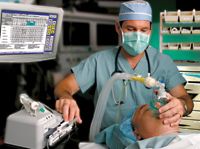New technology enhances safety of anesthesia at point of care
Docusys is a new software that improves anesthesia safety, according to hospitals that have tried it.
Even more than other physicians, anesthesiologists are slow to adopt electronic information software to monitor drug administration. "Only 3% to 4% use anesthesia information management systems (AIMS) in the operating room," said Joseph E. Heins, Pharm.D., executive VP and COO of DocuSys in Mobile, Ala. "But we are seeing a growing interest, and improvement in AIMS technology is encouraging more anesthesiologists to move away from paper recordkeeping."

"A move towards automated information systems and the use of related databases is just as inevitable in anesthesia as it has been in other areas of health care and industry," said Daniel Thys, M.D., chairman of the department of anesthesiology at St. Luke's-Roosevelt Hospital Center in New York. He pointed to a study by Duke University researchers that found use of AIMS technology potentially saves a health system as much as $1 million a year through avoiding errors and creation of electronic records for billing and utilization management.
It also automates documentation of drug utilization through creation of the DocuSys electronic medical record, including professional fee capture, drug supply tracking, and electronic billing. The system's modular design allows integration with existing hospital information systems, said Heins, as well as electronic drug dispensing cabinets, infusion pumps, physiologic monitors, and other systems in settings where IV drug delivery occurs. "This is a significant safety asset," he said.
That is a key aspect of AIMS technology. A recent study by U. S. Pharmacopeia found that surgery patients are three times more likely to experience a harmful medication error than patients anywhere else in the healthcare system. Dosing and communication errors were principal contributing factors to the 3% of anesthesia-related perioperative errors that result in harm, according to USP.
"AIMS technology and automated drug delivery hold promise to reduce these errors," said Peter Pronovost, M.D., an author of the USP report and medical director of the Center for Innovations in Quality Patient Care at the Johns Hopkins University School of Medicine.
Anesthesiologists at Southeast Alabama Medical Center in Dothan, Ala., have been using DocuSys and DocuJect for three years. "The elimination of handwritten records, creation of real-time charts, and real-time notification of potential adverse drug interactions and even expiration dates have been valuable," said Beth Hovey, R.Ph., OR pharmacy supervisor at Southeast Alabama Medical Center.
DocuSys anticipates increased use of AIMS technology as electronic medical records are more widely adopted throughout health systems, said Heins. "No doubt the growth of EMR adoption in other departments will spread to anesthesiology," he said, "especially as anesthesiologists begin to appreciate the significant safety factors inherent in real-time alerts."
"Anesthesiologists who embrace new technology place themselves at a significant competitive advantage," Thys concluded.
More information is available at http://www.docusys.net/.
THE AUTHOR is a writer based in Gettysburg, Pa.